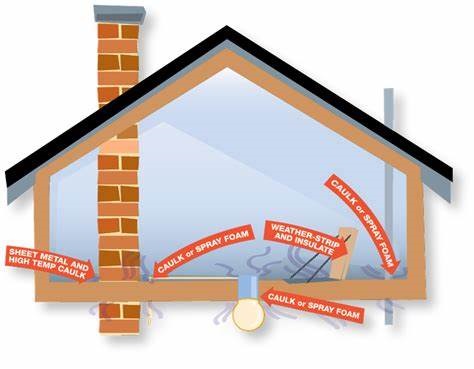Your home is your castle, but it’s also an expensive investment. In order to protect that investment and keep energy costs down, you need to ensure that your home is properly air sealed. Air sealing is the process of preventing air leakage in and out of your home.
Without an air seal, your home cannot provide the comfort and energy efficiency you need to enjoy a healthy and comfortable living space. The process of air sealing your home can range from simple DIY tasks to more complex projects. In this article, we will discuss the various options available for air sealing your home.
#1. Weatherstripping
One of the simplest ways to air-seal your home is to use weatherstripping on your doors and windows. Weatherstripping is a thin layer of material that seals the cracks and gaps between surfaces, preventing air from entering or escaping. Weatherstripping can be made of foam, metal, rubber, or vinyl.
Types of weatherstripping include:
- V-seal – This type of weatherstripping is best for windows, as it provides an airtight seal around the window frame.
- Spring metal – This type of weatherstripping is best for doors, as it pops into place and creates a tight seal.
- Self-adhesive foam – This type of weatherstripping is best for windows, as it provides an airtight seal and can be easily installed.
- Magnetic – This type of weatherstripping is best for doors, as it creates an airtight seal when the door is closed.
Weatherstripping can be a great way to seal your home without spending too much money, as it is fairly inexpensive and easy to install. When installed properly, it will effectively keep air from entering and leaving your home.
#2. Caulking
Another way to air-seal your home is to use caulk around your windows and doors. Caulk is a sealant that prevents air from entering or leaving your home by filling in the gaps between surfaces. It is a great way to fill in gaps and cracks that may be too small for weatherstripping.
When caulking, it’s essential to choose the right type of caulk for your project. Different types of caulk have different properties and should be used for specific applications. For example, silicone caulk, a popular caulk in Texas, is best for sealing around windows, while acrylic latex caulk is best for sealing around doors and siding.
Once you have chosen the right type of caulk, it’s essential to apply it correctly. When applying caulk, fill in gaps completely, as any small gaps can still allow air to escape. Also, ensure the caulk is free of lumps and bumps, as these can cause air leaks.
#3. Insulation
Insulation is one of the most important aspects of air-sealing your home. Not only does insulation help to keep the heat in during the winter, but it also helps to keep air from entering or leaving your home. In order to properly insulate your home, you should install insulation in the walls, attic, and any other areas where air can escape.
When choosing insulation for your home, choosing the right type for your climate and application is essential. Different types of insulation have different R-Values, which measure the amount of resistance they provide against heat flow. The higher the R-Value, the better the insulation for your home.
One of the most popular insulation homeowners in Keller, opt for is spray foam insulation. Spray foam is an excellent option for air sealing your home as it expands to fill any gaps and cracks in the walls or attic. If you’re looking to install insulation in your home, it’s worth considering hiring from an insulation company on https://ifoam.com/keller-texas, as their specialized equipment and expertise can ensure a high-quality work.
#4. Sealing Ducts
Sealing your home’s ductwork is another excellent way to prevent air from entering or leaving your home. Ducts are the channels that carry air from your heating and cooling system throughout your home. If not properly sealed, these ducts can be a massive source of air leaks, as air can escape through cracks and gaps in the ducts.
To properly seal your home’s ductwork, you should use mastic sealant. Mastic is an adhesive that provides an airtight seal when applied to ducts. When applying mastic, it is important to thoroughly cover any cracks, gaps, or seams in the ducts.
Once you have sealed your home’s ductwork, it is essential to inspect it regularly for any air leaks. Air leaks in ducts can cause your energy bill to skyrocket, so it is vital to check for any air leaks on a regular basis.
In conclusion, air sealing your home is a crucial way to save energy, reduce utility bills, and improve the comfort of your home. There are many different ways to air sealing your home; the best ways are to use weatherstripping, caulk, insulation, and mastic sealant. When done correctly, these methods will effectively keep your home sealed and free from air leaks.
 World inside pictures Collect and share the best ideas that make our life easier
World inside pictures Collect and share the best ideas that make our life easier








